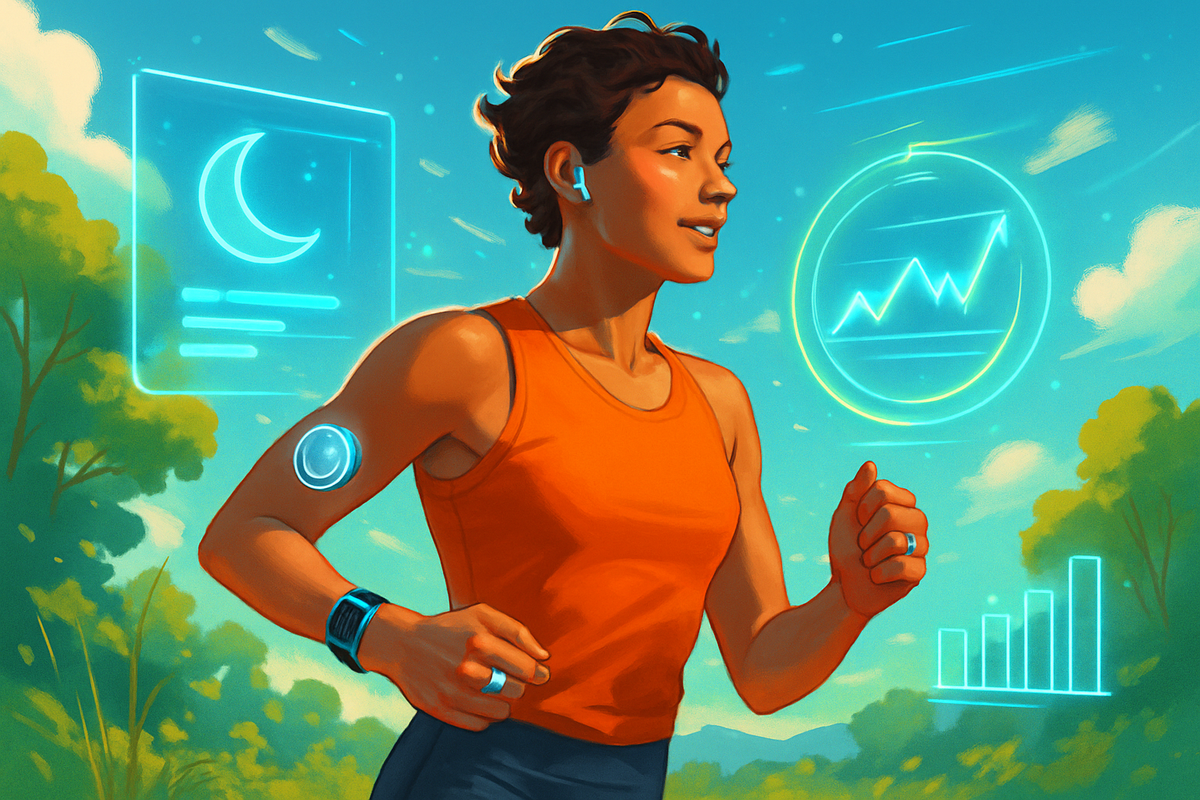The Biohacking Revolution: How AI and Wearables Are Redefining Personal Health in 2025
Welcome to 2025, where AI-powered wearables transform health data into actionable insights, giving everyone the power to optimize wellness. This isn't just for tech elites; it's your path to better sleep, recovery, and performance optimization.

Welcome to the Era of the Data-Driven Human
2025 is not your parents’ wellness world. Forget the dusty step-counters and the “just eat kale” advice—today, we’re strapping mini-labs to our wrists, fingers, and even our pajamas. AI-powered wearables and a new arsenal of biohacking tools are giving everyone, not just pro athletes or Silicon Valley CEOs, the power to optimize sleep, supercharge recovery, and tune performance to symphonic perfection.
“Self-quantification isn’t a trend—it’s the new baseline. The real revolution? AI making sense of your biology in real time, so you can act on it.”
AI + Wearables: Your Personal Health Team, On Demand
The explosive convergence of artificial intelligence and next-gen sensors means your health data is no longer just numbers—it’s actionable intelligence. Here’s how the vanguard of biohacking is getting smarter, sleeker, and more accessible:
- Smart Rings & Bands: Devices like the Oura Ring and Whoop Band deliver 24/7 tracking of sleep cycles, HRV (heart rate variability), readiness, and recovery. AI algorithms interpret the data, giving you daily nudges—"Tonight, aim for an earlier bedtime," or "Your recovery score is off the charts—crush that workout!"
- Continuous Glucose Monitors (CGMs): Tools from Levels and Abbott’s Libre Sense let you see how your coffee, sprints, or 11 pm pizza affect your blood sugar in real time. AI-powered insights now help users spot hidden metabolic saboteurs and personalize nutrition—no finger pricks required.
- Sleep Tech: Eight Sleep’s AI mattress pads learn your sleep patterns and adjust temperature to optimize deep sleep. Meanwhile, wearables like Apple Watch and Garmin use AI to predict your best bedtime and detect micro-awakenings you never knew you had.
- Biohacking Apps: From Apple Health’s AI-driven summaries to advanced platforms like Ultrahuman and Whoop, your phone is a command center for your biology, integrating activity, stress, and recovery data for actionable daily rituals.
Real-World Case Studies: Biohacking in Action
Meet the Modern Optimizers
- The Sleep Warrior: A high-performance executive uses a smart ring and AI mattress to slash nighttime wakeups and improve REM sleep by 18%—all tracked and validated with weekly reports.
- The Recovery Pro: An amateur triathlete pairs a Whoop band with AI-guided active recovery. After a marathon, her HRV rebounds in half the usual time, thanks to personalized breathing protocols and sleep adjustments.
- The Glucose Whisperer: A tech-savvy foodie uses a CGM linked to an AI nutrition app. He discovers his "healthy" oat milk latte spikes his glucose, so he swaps it for black coffee—energy crashes gone, and focus up.
These aren’t just outliers—they’re your coworkers, your neighbors, your future self.
Latest Product Launches & What’s Next
- Smart Rings 3.0: New models boast blood oxygen, skin temperature, and even hydration sensors, all interpreted by on-device AI for instant feedback.
- Non-Invasive CGMs: 2025’s top biohacking wish list—CGMs that don’t break the skin, finally hitting mainstream markets.
- Multi-Sensor Sleep Tech: Mattress pads and wearables now integrate with home environments, using AI to sync lighting, sound, and temperature for perfect circadian alignment.
- Personalized Supplementation: AI-driven apps analyze your wearable data and recommend (or even ship) custom supplement stacks based on real-time needs.
Your 2025 Biohacking Playbook: 5 Power Moves
- Start Simple: Begin with a wearable that tracks sleep, HRV, and movement. Don’t try to optimize everything at once—consistency beats complexity.
- Connect the Dots: Use AI-powered platforms that integrate all your data—don’t let your sleep, nutrition, and workout stats live in silos.
- Experiment (Safely): Try adjusting bedtime, meal timing, or workout intensity and watch how your metrics shift. Let AI surface patterns you’d never notice alone.
- Prioritize Recovery: Your body is a high-performance machine—rest and HRV tracking are as crucial as step counts or calorie burns.
- Stay Curious (and Skeptical): Not every trend is gold. Lean on real data, and don’t hesitate to consult health professionals when exploring new tech or supplements.
“Your biology is not your destiny—especially when you’ve got AI in your corner.”
The Takeaway: Own Your Health Story
Biohacking in 2025 is about empowerment, not obsession. With AI and wearables, you’re no longer guessing—you’re experimenting, learning, and improving, one data point at a time. Whether you’re chasing a new marathon PR, deeper sleep, or just sharper mornings, the tools are in your hands (literally).
Ready to go deeper?
Subscribe to Funaix for free and join a community of health hackers, data geeks, and early adopters. Subscribers get exclusive news, smart commentary, and—yes—access to our blog comments section. Subscribing is free (for now), so take the leap!
Stay curious, stay optimized, and see you in the comments—if you’re a Funaix Insider!




